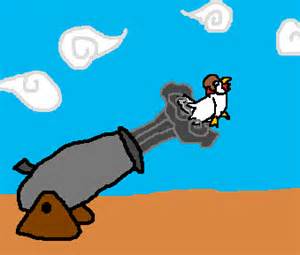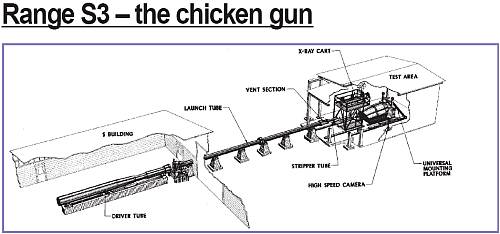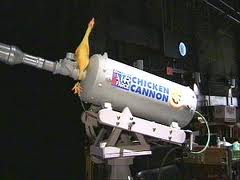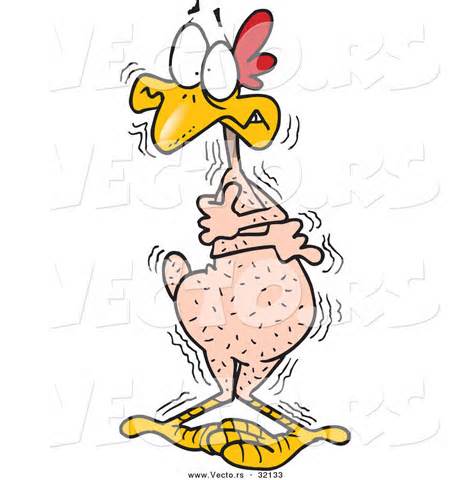
Scientists at NASA built a gun
specifically to launch a standard 4 pound dead chicken at the
windshields of airliners, military jets and the space Shuttle, all
traveling at maximum velocity. The idea is to simulate the frequent
incidents of collisions with airborne fowl to test the strength of the
windshields.

British engineers heard about the gun and were eager to test it on the windshields of their new high speed trains. Arrangements were made, and a gun was sent to the British engineers.

WHEN THE GUN WAS FIRED, THE ENGINEERS STOOD SHOCKED AS THE CHICKEN HURLED OUT OF THE BARREL, CRASHED INTO THE SHATTERPROOF SHIELD, SMASHED IT TO SMITHEREENS, BLASTED THROUGH THE CONTROL CONSOLE, SNAPPED THE ENGINEER'S BACK-REST, AND EMBEDDED ITSELF IN THE BACK WALL OF THE CABIN, LIKE AN ARROW SHOT FROM A BOW.

British engineers heard about the gun and were eager to test it on the windshields of their new high speed trains. Arrangements were made, and a gun was sent to the British engineers.

WHEN THE GUN WAS FIRED, THE ENGINEERS STOOD SHOCKED AS THE CHICKEN HURLED OUT OF THE BARREL, CRASHED INTO THE SHATTERPROOF SHIELD, SMASHED IT TO SMITHEREENS, BLASTED THROUGH THE CONTROL CONSOLE, SNAPPED THE ENGINEER'S BACK-REST, AND EMBEDDED ITSELF IN THE BACK WALL OF THE CABIN, LIKE AN ARROW SHOT FROM A BOW.
THE HORRIFIED BRITS SENT NASA THE DISASTROUS
RESULTS OF THE EXPERIMENT, ALONG WITH THE DESIGNS OF THE WINDSHIELD AND
BEGGED THE U.S. SCIENTISTS FOR SUGGESTIONS.
NASA RESPONDED WITH A ONE-LINE MEMO:
"DEFROST THE CHICKEN."


.......
SNOPES: TRUE or FALSE
SNOPES: TRUE or FALSE
Variations:
Depending upon whom you hear the story from, the
FAA, NASA, the Air Force, or "an American aircraft company" lends its
chicken gun to engineers in another country.
The most common telling says those engineers
were British, but other versions of the story say they were French or
American. Likewise, what's being tested varies, with train windows, jet engines, and cockpit canopies mentioned.
In my favorite version, a cat sneaks into the
barrel of the gun and is helping itself to a cold chicken dinner when
the contraption is fired. (Then again, I just like saying
"catapoultry.")
Origins: There is at least one shred of truth in
this tale — the story did run in the November 1995 issue of Feathers,
the California Poultry Industry Federation's newsletter. That doesn't
mean the CPIF vetted it, though. They had picked it up — the same way
everyone else had — from a friend of a friend. Further adding to the
confusion over the validity of this tale, army Lt. Gen. Wes Clark has
claimed the story is real on a number of occasions and is fond of using
the anecdote in speeches.
Much as we hate to disagree with anyone with an
army behind him, we just have to. The basic story (frozen bird fired by
nincompoops) has been around for years, with the details always in
flux. One researcher spotted a 1990 version, except in it those foolish
British train
engineers were said to be American jet engine designers, thus the frozen chicken was fired not at a train window but at a jet engine. A 1988 book about Australian urban legends contained our chicken cannon tale — in that version, once again American engineers testing a jet engine mistakenly fire a frozen chicken at it with disastrous results. That 1988 sighting of our legend describes it as "an old legend of uncertain origin" which "re-emerged briefly in Australia after the space shuttle disaster of January 1986."
engineers were said to be American jet engine designers, thus the frozen chicken was fired not at a train window but at a jet engine. A 1988 book about Australian urban legends contained our chicken cannon tale — in that version, once again American engineers testing a jet engine mistakenly fire a frozen chicken at it with disastrous results. That 1988 sighting of our legend describes it as "an old legend of uncertain origin" which "re-emerged briefly in Australia after the space shuttle disaster of January 1986."
The chicken gun (also known as the chicken
cannon, turkey gun, or rooster booster) has been around since 1972. It's
used for the "chicken ingestion test," one of a series of stress tests
required by the Federal Aviation Administration before a new jet engine design can be certified. The tests take place in a concrete building large enough to enclose an entire jet
engine. With the engine operating at full speed, the cannon uses
compressed air to shoot chicken carcasses into the turbine at 180 mph.
(The Air Force is known to launch its poultry projectiles at 400 mph
into F-16 canopies.)
Bird strikes can cause extensive damage to
aircraft and serious injuries to their crews. At worst, they can be
deadly confrontations. The Air Force estimates that planes hit about
3,000 birds every year, causing damages of $50 million
and sometimes loss of human life. In a bird-strike accident in
September 1995, 24 AWACS crew members were killed after takeoff from
Elmendorf Air Force Base, Alaska.
Some engineers prefer to go for realism in
these tests and thus buy still-feathered firing fowl from game farms.
(Er, at this point I should mention the birds are dead when cannonized.)
Others, however, buy their catapulting poultry at the supermarket.
Those who favor using thawed birds keep the carcasses frozen until just
before test time, when a session in the microwave restores the avian
missiles to a more natural condition. Not everyone fires thawed birds:
before switching to fake birds, the U.S. Air Force traditionally
launched frozen ones. (Sensitive to the concerns of animal-rights
activists, they now fling birds made of clay and plastic at canopies and
engines.) The way the Air Force had it figured, if a canopy could
survive an impact with a frozen bird, it would certainly live through a
chance introduction to one that could still fly under its own power.
They further believed cold chickens provided a better simulation of a
bird that had tensed to prepare for the impact.
That at least one high profile group of chicken
flingers has used frozen poultry in its cannonizations puts this
legend's punch line — and thus the legend itself — into the realm of
lore, not that of reality. Clearly, it's not all that intuitive to use
thawed poultry in these tests. Just as clearly, firing a frosted pullet
bullet at something to be impact-tested isn't all that unreasonable an
action to take.
The legend's appeal lies in its aura of smug
superiority that "we" are smarter than "them." We, says the legend,
would have known to use thawed birds. Moreover, when the other country
screwed up, its engineers couldn't figure out the error on their own. We
thus earned even more of a mental pat on the back in that it was our
engineers who had to explain the "obvious" to these brainless
foreigners.
Barbara "chicken catch-a-story" Mikkelson
Last updated: 21 July 2007



No comments:
Post a Comment